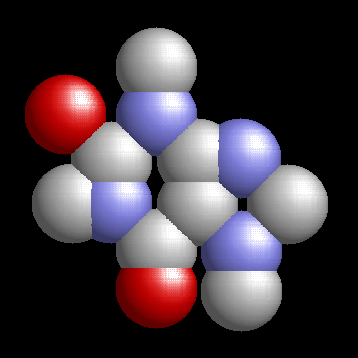
Welcome to Molecules@gnu-darwin.org
Molecule News and Molecule of the Day
Linksalphanumeric indexsdf archives numeric index pdb files by numeric sdf files by numeric Search warning: not yet fully spidered |
This site is under constant constructionThe molecule of the day is: CaffeineCaffeine is one of the most popular molecules in the world, mainly because it is the most interesting ingredient in coffee. Caffeine belongs to the purine class of molecules, which figure prominently in some of the most fundamental processes of the cell, such as replication, transcription, translation, energy metabolism, and signalling. Caffeine itself is thought to exert its effects as an adenosine receptor agonist, but the effects are likely to be more broad than that, due to its similarity with other purines. This would be consistent with the disparate physiological effects of this mild stimulant. Taken in excess, it can result in the jitters, or even an anesthetic effect, which is probably not very healthful. In moderation, the effects may be beneficial. other names: 1,3,7-Trimethyl-2,6-dioxopurine 1,3,7-Trimethylxanthine 1H-Purine-2,6-dione, 3,7-dihydro-1,3,7-trimethyl- 3,7-Dihydro-1,3,7-trimethyl-1H-purine-2,6-dione 58-08-2 Alert-Pep Cafamil Cafecon Cafeina Caffein Caffeine, synthetic Caffine Cafipel Coffeine Eldiatric C Guaranine Koffein Mateina Methyltheobromide Methyltheobromine NCI-C02733 NSC5036 Nix Nap No-Doz Nodaca Refresh'n Stim Thein Theine Theobromine, 1-methyl- Theophylline, 7-methyl WLN: T56 BN DN FNVNVJ B1 F1 H1 Xanthine, 1,3,7-trimethyl component of A.S.A. Compound component of A.S.A. and Codeine Compound component of Ansemco 2 component of Cafergot component of Dilone component of Midol component of P-A-C Compound component of Percobarb component of Percodan component of Phensal related molecule names: molecule directory: 54254
related molecule directories:
related molecule pdb files: |
 pdb file, 54254.pdb CAS: 58-08-2 |
Molecule News
updated Tue Aug 19 19:45:09 EDT 2008Some facts: The Molecules website contains more than 4 million small molecule structure files in pdb format, and molecular graphics representations. About 50 million molecules are still in the pipe, and they are expected to appear here over the course of the next few weeks and months. The pdb format is readable by common FOSS molecule viewer software, such as RasMol and PyMOL. In due course, we plan to provide high quality structures via energy minimization refinement, and additional resources.
Molecules@gnu-darwin.org is founded in the spirit of free software, open source, and public access. It is hoped that access to these files will be a wonderful community resource for science education, research, and entertainment as well. We are looking for investment or funding to expedite and expand this work, and lead the field, with an eye towards an advanced, complete, synthetic, structural, and informatical bioorganome. Meanwhile, the site is already an exceptional lab resource, and molecular catalog, providing the means and building blocks towards additional novel structures. We aim to be the best.
The structural biology, protein crystallography, and molecular graphics talent that is building the Molecules archive is available to work for you in a contract or consulting arrangement. Wide-ranging expertise is available. Molecules@gnu-darwin.org is built entirely with FOSS, free and open source software, GNU-Darwin OS, and it is under the aegis of The GNU-Darwin Distribution. Here is a link to the Distribution résumé. Our founder is an X-ray laboratory admin for the Department of Biophysics and Biophysical Chemistry of Johns Hopkins University School of Medicine. You can also read his CV. We would like to build a community around this website, and we are looking for volunteers and collaborators to help. Regarding any aspect of the work of this site, please feel free to contact us, molecules@gnu-darwin.org, with gdmolecules in the subject line. Cheers!